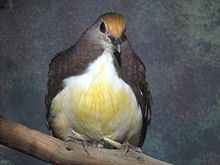Golden breast dove
| Golden breast dove | ||||||||||||
|---|---|---|---|---|---|---|---|---|---|---|---|---|

Breeding golden breast pigeon |
||||||||||||
| Systematics | ||||||||||||
|
||||||||||||
| Scientific name | ||||||||||||
| Gallicolumba rufigula | ||||||||||||
| ( Pucheran , 1853) |
The golden breast dove ( Gallicolumba rufigula ), also known as the yellow breasted or golden breasted earth dove , is a species of pigeon birds. It occurs in three subspecies only in a small range in Southeast Asia.
Appearance
The golden breast pigeon reaches a body length of 22 to 24 centimeters. It is thus slightly larger than a laughing dove , but smaller than the Luzon dagger-stinging dove . Sex dimorphism is only very slightly pronounced.
The forehead is light reddish brown and merges into a chestnut brown at the back of the head. Neck, mantle, back, wings and sides of the chest have the maroon shade. The neck and the sides of the chest shimmer purple. The wings are dark brown with rust-red outer flags. The wings are crossed by three matt gray ribbons. The throat, chest and belly are white and sharply demarcated against the chestnut-brown plumage on the upper side of the body.
The name of the species is the large, golden-yellow spot on the chest. It consists of feathers with a hairy structure. The under tail-coverts are reddish yellow. The beak is dark gray and brightens towards the tip. The iris is reddish brown. Females are largely similar to males. However, their breast and forehead coloring is a little more dull than that of the male. The head is also a little more delicate.
Spread and behavior
The nominate form is native to western New Guinea and occurs on the island of Yapen , among other places . The subspecies Gallicolumba rufigula helviventris occurs in the Aru Islands . The subspecies Callicolumba rufigula alaris is native to southern New Guinea.
The habitat of the golden breast pigeon is mountain forest up to 1,600 meters above sea level. But it also colonizes lowland forests. Like all Indo-Pacific pigeons , it spends most of the day on the ground.
The golden breast pigeon courtship takes place exclusively on the ground. The male pursues the female. As soon as the male faces the female head-on, the male buckles in his heels and emits a hastily brought forward trrr , reminiscent of the trills of a canary . The nest is built very low in the bushes. The clutch consists of only one egg, which is light yellow. The incubation period is 18 to 19 days. The young birds fledge after 19 to 20 days.
Keeping in human care
The golden breasted earth dove was first kept by the London Zoo in 1915. Offspring took place in the 1930s and 1940s. In Germany, the Wilhelma in Stuttgart first held this pigeon species from 1968. The first German offspring came from the Vogelpark Walsrode , which kept golden breast pigeons from 1977. The golden breast dove is a species that can socialize very well with other pigeon birds. It shows its peaceful behavior towards other bird species. However, it needs a heated shelter for wintering.
If kept well, golden breasted pigeons can get very old. One of the pigeons kept in Wilhelma from 1968 onwards reached an age of 26 years.
literature
- Bruce M. Beehler , Thane K. Pratt: Birds of New Guinea; Distribution, Taxonomy, and Systematics . Princeton University Press, Princeton 2016, ISBN 978-0-691-16424-3 .
- David Gibbs, Eustace Barnes and John Cox: Pigeons and Doves - A Guide to the Pigeons and Doves of the World . Pica Press, Sussex 2001, ISBN 90-74345-26-3 .
- Alois Münst and Josef Wolters: Tauben - The species of wild pigeons , 2nd expanded and revised edition, Verlag Karin Wolters, Bottrop 1999, ISBN 3-9801504-9-6 .
- Gerhard Rösler: The wild pigeons of the earth - free living, keeping and breeding . M. & H. Schaper Verlag, Alfeld-Hannover 1996, ISBN 3-7944-0184-0 .
Web links
- Gallicolumba rufigula inthe IUCN 2013 Red List of Threatened Species . Listed by: BirdLife International, 2012. Retrieved January 4, 2014.

